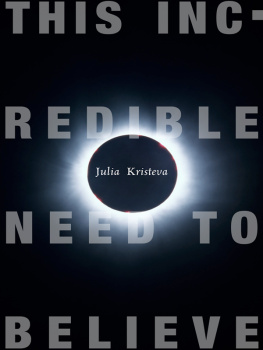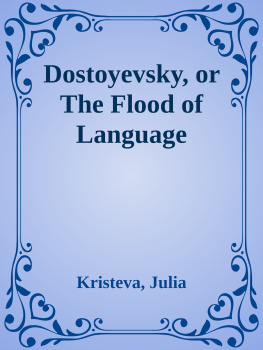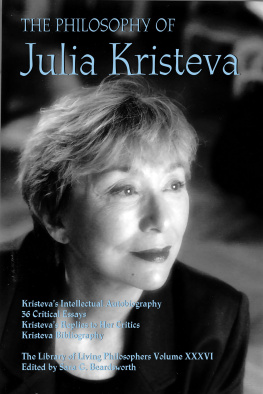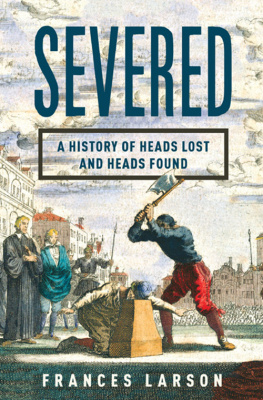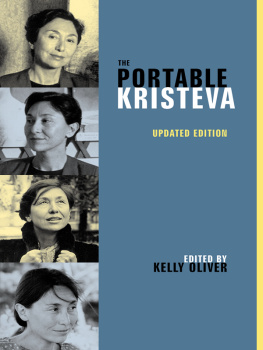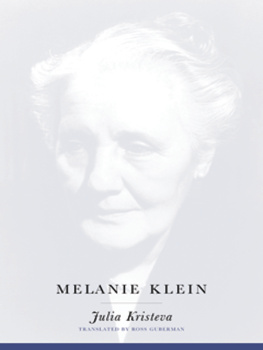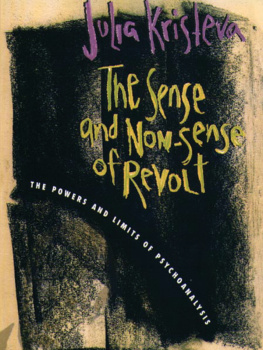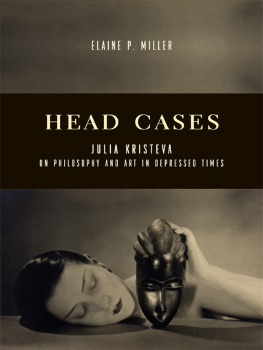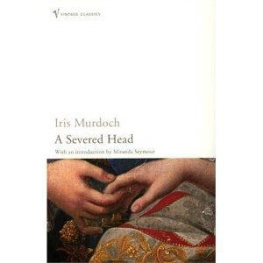THE SEVERED HEAD
EUROPEAN PERSPECTIVES
A SERIES IN SOCIAL THOUGHT AND CULTURAL CRITICISM
EUROPEAN PERSPECTIVES
A Series in Social Thought and Cultural Criticism
Lawrence D. Kritzman, Editor
European Perspectives presents outstanding books by leading European thinkers. With both classic and contemporary works, the series aims to shape the major intellectual controversies of our day and to facilitate the tasks of historical understanding. For a complete list of books in the series, see .
THE SEVERED HEAD
CAPITAL VISIONS
Julia Kristeva
Translated by Jody Gladding

COLUMBIA UNIVERSITY PRESS NEW YORK
COLUMBIA UNIVERSITY PRESS
Publishers Since 1893
New York Chichester, West Sussex
cup.columbia.edu
Copyright 2012 Columbia University Press
All rights reserved
E-ISBN 978-0-231-53038-5
Library of Congress Cataloging-in-Publication Data
Kristeva, Julia, 1941
[Visions capitales. English]
The severed head: capital visions / Julia Kristeva; translated by Jody Gladding.
p. cm. (European perspectives)
Includes bibliographical references and index.
ISBN 978-0-231-15720-9 (cloth: alk. paper)
1. Head in art. 2. Beheading in art. 3. Art, EuropeanThemes, motives. I. Title. II. Series.
N8217.H5K7413 2011
704.942dc23
2011020717
A Columbia University Press E-book.
CUP would be pleased to hear about your reading experience with this e-book at .
References to Internet Web sites (URLs) were accurate at the time of writing. Neither the author nor Columbia University Press is responsible for Web sites that may have expired or changed since the book was prepared.
TO MY MOTHER
Are we inevitably slaves to the image? Not for certain, answer the philosophers, uncertain by profession. The image is potentially a space of freedom: it annihilates the constraint of the object-model and replaces it with the flight of thought, the wandering of the imagination. I would add, and this is my particular bias, that the image may be our only remaining link to the sacred: to the terror that death and sacrifice provoke, to the serenity that follows from the pact of identification between sacrificed and sacrificing, and to the joy of representation indissociable from sacrifice, its only possible course. The following pages will try to show that certain images and certain facial expressions can still offer an experience of the sacred to the humans that we are, ever more absorbed in technology. What images? What expressions? What sacred?
The stories behind the severed heads in question here are cruel. Through them, a humanity possessed by the urge for death and terrorized by murder acknowledges that it has, in fact, arrived at a fragile and overwhelming discovery: the only resurrection possible may be representation. The decapitations on display are proof of it. I invite you to make your way from their violence to their refinement, so that at the end of the journey you can conclude for yourself that, with or without decapitation, all vision is nothing other than capital transubstantiation.
CONTENTS
Exhibitions let us see some portion of the work done in a museum. Nonetheless, they dont represent the essence of it and in any case only show us the results, however provisional, of prior research. But these events seem to receive more attention that any other activity, no doubt because of their brevitya few weeks, their selective naturea small space with rare works, and especially because of the engagement they presuppose. An exhibition is meant to be captivating or at least convincing and arresting. An exhibition is valued for its critical quality and the depths of its interrogation. It prompts different reactions than visits to the permanent collections do. Also, public opinion is easier to gauge because it is solicited directly by the comparison offered. In short, any exhibition is a biased view. The following work, which the department commissioned ten years ago, deliberately poses this question of subjective discourse on art, mixing genres and periods but concentrating especially on drawing and engraving. Biased views are conceived, as Rgis Michel reminds us, as spaces of interpretive freedom. They are not a rupture but an opening, and they claim the right of difference. The audience they attract is aware of their singularity and especially the nature of the view they offer. These exhibitions are not in opposition to the ones the department organizes side by side with them. They share the same rigor and the same excitement. By giving those we invite carte blanche, these exhibitions allow them to adapt their commentaries to the works they discover with us. A museum, especially a very large one, can allow for a treasure hunt. With its infinite possibilities, drawing lends itself to this better that any other genre.
Julia Kristevas work is so well known, in France as abroad, that there is no need to introduce it. Beyond the reflections it offers on language and literature, psychoanalysis and anthropology, this work centers largely on art and images, even Kristevas fiction. That is the case with her latest novel, Possessions. Julia Kristevas approach is not a matter of historical inquiry, but of profound meditation, and its nature is perfectly summarized by the title of the first work in which art analysis unfolds: Powers of Horror. This biased view, the fifth in this series of exhibitions, owes much to that experience of the image, which, for Kristeva, always falls into the category of the tragic. The theme she has chosen attests to this. It has drawn uponthanks to an inquiry conducted over nearly two years, in which the Department of Graphic Arts was very much involveda selection of works of all kinds treating a single theme: decapitation. As cruel as it is current, it perfectly crystallizes the interpreters investigations, and her persuasive argument, which leads to the question of representationssacred, secularof the human face, wins support through the breadth of its sources and the power of its ideas.
This is the first time a woman is involved in this series of exhibitions, and it is very much a womans voice that we hear in the following pages. The very reason for this series is to emphasize differences in discourse. So it will come as no surprise that this text is, precisely, a continualand latentinterrogation of feminine identity, through biblical and mythological themes, as proposed to us by Western art. In the course of this analysis, in which Freud is the major reference, the feminine figureand simply the human figureare evoked in the infinite complexity associated with what we want to show and what we mean to hide.
Aesthetic barbarism today is accomplishing what has threatened intellectual formations since they were brought together as culture and neutralized. To speak about culture always went against the grain of culture.
MARX HORKHEIMER AND THEODOR W. ADORNO,
THE CULTURE INDUSTRY: ENLIGHTENMENT AS MASS DECEPTION
TOOTHPASTE SMILE
In a major text, which is hardly cited anymore (a sure sign of its importance), Horkheimer and Adorno define mass culture by its advertising function, by which works of art are reduced to political slogans, as accessible to everyone as public parks: Because, in this industrial production of media rubbish, the value of cultural goods ceases to be a use value and becomes an exchange value (128)a social valuewhich no longer has any value in and of itself: any value at all. It is something between artifact, accessory, and fetish. Something probably far from meaning, pleasure, and experience. In this totalitarian aesthetic of reification (we can just as easily say cultural
Next page


